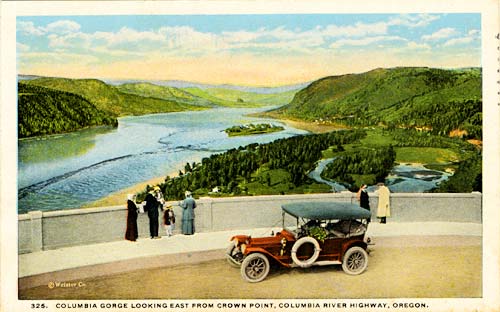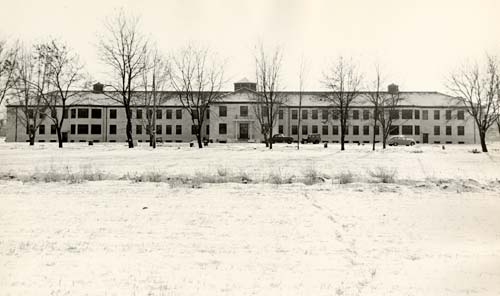 Tourists take in the panoramic view looking east from Crown Point in the Columbia River Gorge. The success of the Columbia River Highway inspired Oregon leaders to improve other state and local roads in the 1920s. (OSA, Accession 88A-057, Postcards)
Tourists take in the panoramic view looking east from Crown Point in the Columbia River Gorge. The success of the Columbia River Highway inspired Oregon leaders to improve other state and local roads in the 1920s. (OSA, Accession 88A-057, Postcards)
Economic Challenges
While the 1920s "roared" in much of the American economy, in many ways they only whimpered in Oregon. World War I heated up Oregon's economy with demand for the production of ships, lumber, grain, and other materials. But in its wake, the state's economy faltered as farming slumped and orders to shipyards and lumber mills declined precipitously. Housing starts dropped, stock market speculation increased, banks grew unsteady. Looking for brighter horizons, 50,000 Oregonians left the state after World War I.
Oregon's Good Roads Movement
One of the impediments to economic prosperity was the state's transportation system. Certainly, Oregon had a network of railroad, stage, and steamboat routes, but its road system could only be described as primitive. A spectacular exception was the just completed Columbia River Highway, which provided both inspiration and impetus to push modern road building forward on a statewide basis. After passing the nation's first gas tax to pay for roads in 1919, Oregon moved at full speed to construct a network of modern paved and concrete roads. The campaign to "Get Oregon Out of the Mud" began to pay dividends as highway projects such as the Pacific Highway and later the Oregon Coast Highway captured the imaginations of wandering Oregonians and Americans. Meanwhile, great efforts went into enhancing a network of farm to market roads linking agricultural communities with railroads and other shipping resources.
Social Freedoms and an Advertising Age
 Actor and filmmaker Charlie Chaplin.
Actor and filmmaker Charlie Chaplin.
As it struggled economically in the 1920s, Oregon also experienced the excitement and fears of a tumultuous social and cultural decade. Changes hastened by World War I expressed themselves in American culture as old traditions waned. Many women, newly empowered by the right to vote on a national level, broke social constraints on dress and behavior. They "bobbed" their hair, discarded their corsets, wore flapper dresses, listened to jazz music, danced the Charleston, and openly smoked cigarettes. Many demanded easier and more equitable divorces along with access to birth control.
Movie idols such as Rudolph Valentino, Clara Bow, Mary Pickford, Douglas Fairbanks, and Charlie Chaplin captivated film audiences. The film plots often followed classic themes that reflected ideals of society: farm boy conquers city while remaining pure; poor boy struggles and saves to achieve wealth and happiness; nice boy meets and marries rich girl. Sports combined with the booming advertising profession to create heroes such as Babe Ruth in baseball and Jack Dempsey in boxing. Radio broadcasts and ownership grew rapidly. Automobiles, made much more useful by the improving roads, provided Oregonians with a level of physical independence they had never known. The world was in many ways a very exciting place.
Darker Currents
Yet troubling aspects of the society dampened the exuberance for many. The great social experiment of Prohibition led to underground economies, increased organized crime, and an erosion of respect for government. Labor strife boiled over at regular intervals, sometimes leading to violence. Fear and distrust of American radicals as well as foreigners grew while Bolsheviks were seen in the shadows of society.
The Twenties also saw growth in the application of Social Darwinism principles to state institutions. The eugenics movement blossomed in Oregon, leading to the violation of the rights of many disabled and incarcerated citizens. Specifically, a 1923 state law provided for "the sterilization of all feeble-minded, insane, epileptics, habitual criminals, moral degenerates and sexual perverts who are a menace to society...."
 Eastern Oregon State Hospital, opened in 1913, was one of several state institutions in which residents were sterilized. (OSA, Board of Control Records, Photographs, Box 1)
Eastern Oregon State Hospital, opened in 1913, was one of several state institutions in which residents were sterilized. (OSA, Board of Control Records, Photographs, Box 1) The Oregon Eugenics Board regularly made decisions to sterilize residents of the Oregon State Hospital, Oregon State Penitentiary, Eastern Oregon State Hospital, and the State Institution for Feeble-Minded [later Fairview Hospital and Training Center]. Officials initially used the law to punish people for having homosexual sex. And, for years they also favored castration over vasectomies as a means of sterilization. The board reasoned that the gene pool would be stronger if "defective" individuals were not allowed to breed. Sterilization was also thought to have a "calming" effect on individuals. Until reforms in 1967, sterilization often was used as a condition of release from state institutions or to punish people who acted out. The board was finally abolished in 1983.
The rise of the Klan
Perhaps the most menacing trend during the decade was the rise of anti-Catholic bigotry and racist vigilante movements, which established a firm foothold in the state. The Ku Klux Klan formed chapters in Portland, Eugene, Medford, Roseburg, and other Oregon communities. Its members donned robes and paraded through streets igniting crosses and intimidating Catholics and minorities. In 1921 Medford Klan organizers perpetrated "necktie-parties" (near lynchings) against two African Americans who they suspected of bootlegging as well as against a piano dealer who had filed a lawsuit against a Klan member. Deploring the incidents, Governor Ben Olcott declared:
But the Klan's rise in the early 1920s carried considerable political clout. In 1923, the Klan-dominated Oregon Legislature passed an Alien Land Law barring Japanese land ownership. The new law came on the heels of a U.S. Supreme Court ruling that Japanese people could not be naturalized citizens. And, the law passed despite the fact that Japanese Americans held less than one percent of Oregon land in 1920. Similar laws passed in Washington, California, and other states.
The organization also endorsed an initiative measure to require children of ages 8 to 16 to go to public schools. While other reasons were given, a primary impetus of the measure was to wipe out Catholic schools in the state. Approximately seven percent of Oregon students attended private schools, many of which were Catholic. Most of the state's newspaper editors either supported the measure or remained neutral.
Turning the Progressive tool of direct legislation into a reactionary weapon, supporters convinced Oregon voters to pass the compulsory school measure by a vote of 115,506 to 103,685 in the November 1922 election. They also managed to get Walter Pierce, who supported the measure, elected governor, replacing Ben Olcott, a staunch opponent.
The Oregon Legislature decided not to enforce the measure until the courts ruled on it. Finally, the U.S. Supreme Court in "Pierce vs. Society of Sisters" unanimously ruled in 1925 that the bill was an unconstitutional violation of parents' rights to send their children to schools of their own choice. By the time of the ruling, the Klan largely had faded from prominence, a victim of internal conflicts, corruption rumors, and the second thoughts of Oregonians.
The tired end of the frenetic decade saw the event that precipitated the next major era of American history, the Great Depression. The stock market crash of 1929 was more of a symptom of the underlying excesses and weaknesses of the economy than it was a cause. But it served as a wake up call for the despairing times ahead.
Notes
(Eugenics Board: Oregon Laws, 1923, Ch. 194; Klan: "An Oregon Century" Web Exhibit by the Oregonian; Compulsory school measure: Dodds, Gordon B., Oregon: A Bicentennial History, 1977; Oregon Blue Book)